Dieter Delecate has spent 61 years in the watch business. He’s seen a few things. In this feature-length profile from the January-February 2016 issue of WatchTime, we profile the notoriously press-shy Delecate and reveal his long and fascinating history with the Tutima watch brand.
In 1954, a young man in Ganderkesee, a town in the northern part of West Germany, heard that a local watch company was hiring. He went to the factory, interviewed with the owner, and got a job. He was 19 years old.
The teenager was Dieter Delecate and he has been working in the watch business ever since, a total of 61 years. He founded Dieter Delecate Uhrenfabrikation in Ganderkesee in 1960, reviving the Tutima brand on his watches. The company, owned and led by him, later became Tutima Uhrenfabrik GmbH. His career has coincided with a series of momentous events that shook and radically reshaped the watch world. Delecate dealt with all of them. An early visitor to Hong Kong, he was able to successfully navigate the quartz-watch revolution that wreaked havoc on so many European watch companies. He was a pioneer of the mechanical-watch renaissance; his mechanical Tutima NATO Chronograph of 1985 was far ahead of its time. And in 1990, in the earliest days of German reunification, he was one of the first West German watch executives to visit the East German watchmaking town of Glashütte, in a quest to return Tutima to its birthplace.

Over the years, Delecate has deliberately kept a low profile. If there must be a spotlight, he prefers it be on his watches, not on him. Recently, though, he agreed to an interview to discuss a watch career that spans seven decades. I met with him, his son Jörg and daughter Ute, both executives with the Tutima Group, and Tutima’s long-time U.S. distributor, Gustavo Calzadilla, at Tutima headquarters in Glashütte to discuss the good life and turbulent times of Mr. Tutima.

I.
“WHY TUTIMA?”
The man who hired Delecate was Ernst Kurtz. Dr. Kurtz, as Delecate always refers to him, is a heroic figure in the history of German watchmaking. He was the founder and head of Glashütte’s largest watch company, UROFA-UFAG, and the creator of the Tutima brand, Glashütte’s first and at that time finest wristwatch. He had come to Glashütte, Germany’s famed center of precision watchmaking, in the mid-1920s to deal with the economic crisis brought on by World War I. The market for fine pocketwatches, Glashütte’s prime product, had collapsed during the war and never recovered. The ravages of the post-war economy plunged several Glashütte watchmaking firms into bankruptcy. A Saxony bank sent Kurtz, a young lawyer, to Glashütte to deal with the crisis.
Over the next two decades, Kurtz revived the industry there. He introduced machine production of wristwatches, using the Tutima label for the top-quality models. In the 1930s, his UROFA-UFAG group employed 1,000 people in Glashütte. World War II, however, destroyed everything Kurtz had built, including the Tutima brand. The day before the war ended, Kurtz and his colleagues fled Glashütte for Bavaria, which was in the American zone of occupation. There, in the town of Memmelsdorf, Kurtz opened a small watch factory. In 1951, he moved the watchmaking operation to Ganderkesee, near Bremen, and produced wristwatches under his own name in the top-quality tradition of Glashütte. The watches carried the logo “KURTZ” with the words “GLASHÜTTER TRADITION” in italic beneath it. As for Tutima, it was gone, bombed into oblivion by the Russian planes that hit Glashütte on May 8, 1945, the day before the war ended.

Kurtz became Delecate’s mentor. “He talked a lot about Glashütte,” Delecate remembers. “Even on the first day, he told me about Glashütte and his past.” And his brand, Tutima. Delecate started in an administrative post, and then moved into sales. In 1957, he set up his own wholesale watch company, acting as an agent for Kurtz watches.
But times were tough. The center of watchmaking in West Germany was now Pforzheim in the south. Kurtz had trouble competing with its low priced, mass produced products. The company changed hands twice before going out of business in 1959.

Delecate moved quickly to preserve his mentor’s legacy. In 1960, he decided to revive the Tutima brand name. He acquired the rights to the brand, hired some of Kurtz’s technical staff and started his own watch production company, Tutima Uhrenfabrik GmbH, in Ganderkesee. His embrace of the Tutima brand was risky. Tutima was from another time and, since 1949, another country, the Communist German Democratic Republic, known as East Germany. “Tutima was the past,” Delecate says, “from Glashütte and the 1930s. Now there was a new time. It was after the war, a new world, a new start. Nobody remembered the Tutima brand from before the war. People didn’t know what it was. Is it Japanese? Is it clothing? What is it? And the young watchmakers, the new watch stores, they didn’t like it. Even my salespeople at that time said, ‘Why do you use this brand? People don’t know it.’” But the 25-year-old boss was adamant. “We must use it,” he told them. “It’s a Glashütte brand. It has a foundation. It has a history.”

With about a dozen technicians assembling movements and watches, Delecate relaunched Tutima, first with ladies’ watches, then gents’. Cheering Delecate on was Kurtz, who was delighted to see the Tutima brand on the German market again. “Dr. Kurtz was a bit surprised,” Delecate says. “He wrote to someone, ‘Oh, Delecate is smarter than me. He’s using the Tutima brand. It’s a big success.’ But he was wrong,” Delecate says, with a smile. “It was difficult. I think he was right to put ‘Glashütter Tradition’ on his dials instead of Tutima at that time.”
Delecate’s commitment to the Tutima brand pleased Kurtz. Delecate still has a private letter in which Kurtz states, “I consider Dieter Delecate my successor.”

There were many challenges in the beginning, Delecate says. Sourcing components was one. Kurtz had gone out of business by insisting on making his own movement components in house. To compete with Pforzheim brands, Delecate had to rely on outside suppliers for components. (Complete mechanical movements were not available in those days; producers assembled their own movements with components purchased from parts suppliers.) But Pforzheim suppliers made life difficult for him. “The Pforzheim people didn’t like to sell movement parts to us in north Germany. We were competition and they didn’t like that.” So he bought movement parts from suppliers in France. Plus, there was competition in the market from a new category of retailer in Germany, department stores, which were verboten for Tutima. Quality mid-priced brands like Tutima were sold in watch shops. Those shops boycotted any brand that attempted to supply watches to department stores. “It was very hard,” Delecate says.
“Then, in 1969, I read somewhere that Hong Kong made watch cases and watch dials, and I said, ‘Oh!’” Off he went.
II.
TO HONG KONG
Delecate does not claim to be the first German watch executive to source parts in Hong Kong. “I was the second,” he says with a smile. He discovered who was first on his first trip there. He was directed to a certain factory that made watch cases. “I saw a number of boxes addressed to a quite well-known Pforzheim brand and that gave me confidence. I ordered 8,000 stainless- steel cases right away. It was a big number for me.” He also bought watch dials there. The deal paid off: he got quality parts at a great price.
Once Delecate started sourcing appearance parts in Hong Kong (he still used French parts for his movements), his watch business picked up. He tapped into the growing department store trade by making private-label watches for Karstadt, a major department store chain in Germany, under its house brand. He was one of Karstadt’s main suppliers of watches for 25 years.
Sales of Tutima watches picked up, too, as Delecate began forging its identity as a rugged, high-performance men’s watch. Jörg Delecate, COO of the Tutima Group, remembers an incident at school in 1973, when he was nine years old. “I had a real sporty watch, a Tutima mechanical with luminous indexes. It was a divers’ watch with a rubber strap and a turning bezel. We went to swimming class and I was the only one wearing my watch in the pool. And the others, even the teacher, said, ‘Hey, you’re still wearing your watch!’ I said, ‘Yes, of course, it’s waterproof.’ That was very unusual at that time. Dieter was already making a lot of good, really tough, watches.”

Then came the quartz revolution, which transformed the watch world in the mid-1970s. Delecate managed it nimbly. By then he knew Far East watch centers very well. He shifted Tutima to an all-quartz line. But soon he gave up quartz digital watches and successfully started production of high-quality analog watches in Ganderkesee, with movements from Switzerland and other parts sourced in Asia. In 1979, he set up his own quartz-watch company in Hong Kong, Tutima Hong Kong Ltd. Why ship all the components to Germany when they could more easily be assembled in Hong Kong? In 1982, he relocated to Hong Kong to manage the business; it became his primary residence. Since then, he has split his time between Hong Kong and Germany. (Today, that operation produces Boccia Titanium quartz fashion watches, a brand Delecate launched in 2002. Boccia Titanium is one of Germany’s best-selling fashion watches, adorning the wrists of such luminaries as Chancellor Angela Merkel.)

III.
THE NATO CHRONO
Not long after Delecate moved to Hong Kong, the German Army solicited bids from German watch companies for an official Air Force chronograph. Their specs required that the watch have a mechanical movement since there was no telling when a quartz watch battery would die. Tutima bid on the contract. Delecate and his team worked hard to fulfill the tough technical conditions of the German government’s tender. They created the requested big-space pushers integrated into the case.

Other pilot requirements were a center chronograph minutes counter with red jet-plane-shaped tip. It was much easier to read than the small 30-minute subdials common to most chronographs. An all-red chronograph seconds hand also swept the full dial. A 12-hour chronograph counter was at 6 o’clock and a 24-hour indicator at 12 o’clock. The watch’s stainless-steel case was 14.5 mm thick to protect the movement from magnetic fields of up to 1,000 oersted and shocks up to 7 Gs. Inside was the self-winding Caliber 5100 from Switzerland’s Lemania.
The West German Army tested the watch and Tutima got the bid. Delecate’s innovative chrono pushers were a decisive factor, he later learned. Tutima began supplying the chronograph to the West German Air Force. It carried the NATO NSN number “6645-12-194-8642.” Also, Germany’s fellow pilots in NATO wore it. In 1985, Delecate offered the watch to the public. But in the “thin is in” watch world of the mid-1980s, there was little interest in Delecate’s thick watch with its old-fashioned movement.
“We tried to sell it, of course,” he says. “We sold some in the retail shops in Germany, but it was not exciting. Japanese quartz watches were exciting. The Japanese flooded Europe with quartz watches. In every store window you saw Japanese quartz analog watches, with colored dials. Mechanical chronographs were not very popular. Only a few people were interested in them.
“That’s why everybody destroyed their mechanical watchmaking equipment,” Delecate says. “There was a manufacturer from Pforzheim whom we met at the time, who said he had 500 mechanical Swiss chronograph movements in his inventory and he threw them away.” Lemania in those days was happy to have orders from Tutima for its movement. “We still have a good relationship with Lemania,” Delecate says of the firm now called Manufacture Breguet.
Once again, he got resistance from his own salespeople, who complained that Delecate’s mechanical clunker was impossible to sell. Delecate’s disappointment was deep. “He was very proud of the NATO Chronograph,” says Jörg. “He always wore it and said it was such a good watch, a mechanical with these special pushers. It was not really appreciated at the time. But he was quite convinced about the NATO watch.” He stuck with it, expanding the collection. To this day, the Tutima NATO Chronograph is standard equipment for the German Air Force. The German military has two workshops in northern Germany devoted strictly to repairing these NATO Chronographs.

Delecate’s NATO watch was ahead of its time. It anticipated trends that would bloom in the next decade: mechanical watches in general, and chronographs and pilots’ watches in particular. Looking back, says Calzadilla, who introduced Tutima to the U.S. market in 1996, “You see how influential and how important the NATO was.” Not only because it was mechanical, Calzadilla says, but because it was the first time Delecate linked the relaunched Tutima to Glashütte and aviation.
In 1989, Tutima produced a brochure promoting the NATO watch. It showed a photo of the Tutima Fliegerchronograph 1941, a watch Ernst Kurtz made for the German Luftwaffe. “Fifty years ago,” the text stated, “Germany’s first wrist chronograph was a Tutima. This Tutima Fliegerchronograph was developed at the beginning of the 1940s in Glashütte, Germany, and was issued as standard equipment to the then Luftwaffe.” Says Jörg, “The picture of the Fliegerchronograph made a historical connection. And on that we got quite interesting reactions. People said, ‘What a nice watch. I would buy it immediately if you made this.’ This was in the 1980s.”
A seed was planted.
IV.
TO GLASHÜTTE
About the same time, Germany underwent the most stunning political upheaval since World War II. The sudden fall of the Berlin Wall in 1989 and German reunification in 1990 made it possible for Delecate to do something he had dreamed of for decades: visit Tutima’s birthplace. Within days of the East German border’s opening, he drove from Ganderkesee to Glashütte. The plan was for Kurtz to join him. Kurtz was eager to meet an old friend from his Glashütte days, Peter Schöne. For many years they had only been able to stay in touch through letters because of the Iron Curtain separating the two Germanys. Unfortunately, Kurtz got sick and could not make the trip.
Twenty-five years after that first visit, sitting in the Tutima workshops in Glashütte, Delecate talked about that trip. “I came to see what was going to happen here. I had to go. I was Mr. Tutima,” he said with a laugh. “I went first to Peter Schöne and handed him a letter with regards from Dr. Kurtz. We had a long talk and I got my first idea about Glashütte from him.
“Everything looked poor here,” Delecate says. “The houses were not painted. Everything was very poor.” The locals showed a huge interest in his 350 Daimler sports car. “Oh, it was a sensation!” he says. Glashütters were accustomed only to the tiny, exhaust-emitting, East German Trabants.

On that trip, he got a souvenir of the Cold War and divided Germany that he has kept. “I remember there was a closed factory here. There was a big pile of trash. In it was a flag with the words ‘Seid bereit,’ ‘Be ready.’ This was a Communist political flag. Somebody said, ‘We don’t need it anymore.’ And I took it.”
The only trace of Tutima was the UFAG building where Tutima watches were made. It was for sale for many years, but there were no buyers and eventually it was torn down.
Delecate went to see if there was any chance to bring Tutima back to Glashütte. He met with executives of VEB Glashütter Uhrenbetriebe (Glashütte Watchmaking Works), known as GUB, the combine that the Communists established in Glashütte after the war. The East German state dismantled most Glashütte watch firms like A. Lange & Söhne, R. Mühle, Otto Estler and Kurtz’s UROFA-UFAG and merged them into GUB. “I met with the management of that factory a few times,” Delecate says. “But it was too early and not so easy. I had my people in north Germany. Here they had a company based on the communist model with 2,000 employees.”
Delecate made several trips to Glashütte in 1990. One GUB executive that he had good discussions with was Hans-Jürgen Mühle, who would himself re-establish the family firm, Mühle-Glashütte, in 1994. Delecate remembers vividly the phone call he got from Mühle informing him that the German company VDO Adolf Schindling, owners of the Swiss watch brands IWC and Jaeger-LeCoultre, would revive the A. Lange & Söhne brand in Glashütte in cooperation with Walter Lange. The new company would be directed by German-born Günter Blümlein, the highly respected head of Switzerland’s IWC and Jaeger-LeCoultre brands. “I thought, ‘Oh my God, what should I do now?’ They had big plans. I had to rethink if I should come to Glashütte at that time. And I didn’t come.” In December 1990, the new A. Lange & Söhne company was established in Glashütte.
But Delecate’s dream did not die. Says Jörg: “We always said that Tutima belongs to Glashütte. That was clear. It has to come back.”

V.
FLIEGERCHRONOGRAPH
In the meantime, Delecate took a step that unmistakably linked his Tutima with Kurtz’s: he relaunched the Tutima Fliegerchronograph of 1941.
Tutima’s NATO Chronograph sparked interest in the original Tutima Fliegerchronograph from World War II. In the 1990s, with interest in mechanical watches growing, watch enthusiasts urged Delecate to remake the watch that UROFA-UFAG was charged to produce for the German Luftwaffe. Between 1941 and 1945, Kurtz’s company manufactured around 30,000 of them. Delecate decided to produce an authentic replica of that watch.
It wasn’t easy. The original UROFA 59 chrono caliber was long gone. To recreate it, Delecate’s “1941” project team had to modify a manual-wind Valjoux 7760. They eliminated the 12-hour counter since the Flieger didn’t have one. The new movement was smaller than the original (13 lignes versus 15). But in every other respect, the new Flieger Classic Chronograph that Tutima unveiled in 1994 was the spitting image of the 1941 original.
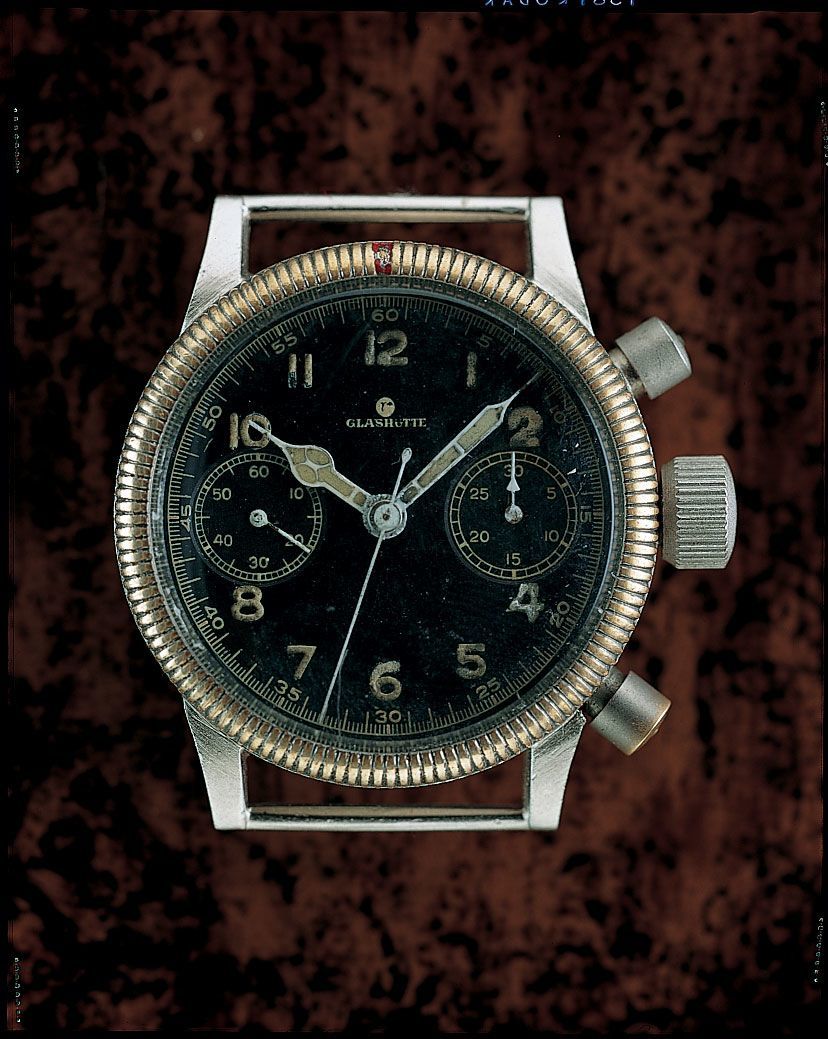

The watch was an instant hit. It became a media darling. “At that time, wealthy people started to take an interest in mechanical watches again,” says Ute Delecate, Tutima’s marketing chief. “I remember an article in Germany’s biggest newspaper, Die Welt (The World). The lead article was about the comeback of mechanics in general, not only in watchmaking. The image for this article was our watch.”
Says Delecate, “All the journalists came and it was very exciting. This was the beginning of the revival of mechanical watches. When they talked about the comeback of the mechanical, it was always our chronograph as an example.”
The Flieger was a commercial success. It became the face of Tutima and the firm’s best-selling family. Delecate followed the Flieger Classic with the Flieger Chronograph F2 (containing the automatic Valjoux 7750 with three subdials); the Flieger Chronograph F3 (with the automatic Lemania 5100 caliber); and non-chronograph versions like the Flieger Automatic and the Flieger GMT.
Looking back, however, Delecate says it could have and should have done even better commercially. His one regret is that he did not do more to promote it. “Everybody came with vintage-styled pilots’ watches. We were overrun,” he says. “My company was not that big. I didn’t have that much capital to invest. We should have built up our identity in north Germany in a bigger way.”
VI.
TAKING TUTIMA HOME
In the following years, the Delecate family continued to visit Glashütte. They watched the town gradually regain its status as Germany’s center of fine mechanical watchmaking. It was only a matter of time before they would bring Tutima home. On a visit in 2005, as a real estate agent drove them through town, they passed a building by the train station with a big sign that said, “I COULD BE YOURS.”
Delecate bought it. By 2008, a team of 20 was already at work on the premises. On May 12, 2011, Delecate cut the ribbon to officially inaugurate Tutima Glashütte SA, the new manufacture. Mr. Tutima had brought the brand back home. In a speech, Delecate paid special tribute to Kurtz and said, “This day has a special meaning for me. A day full of past, present and future.”
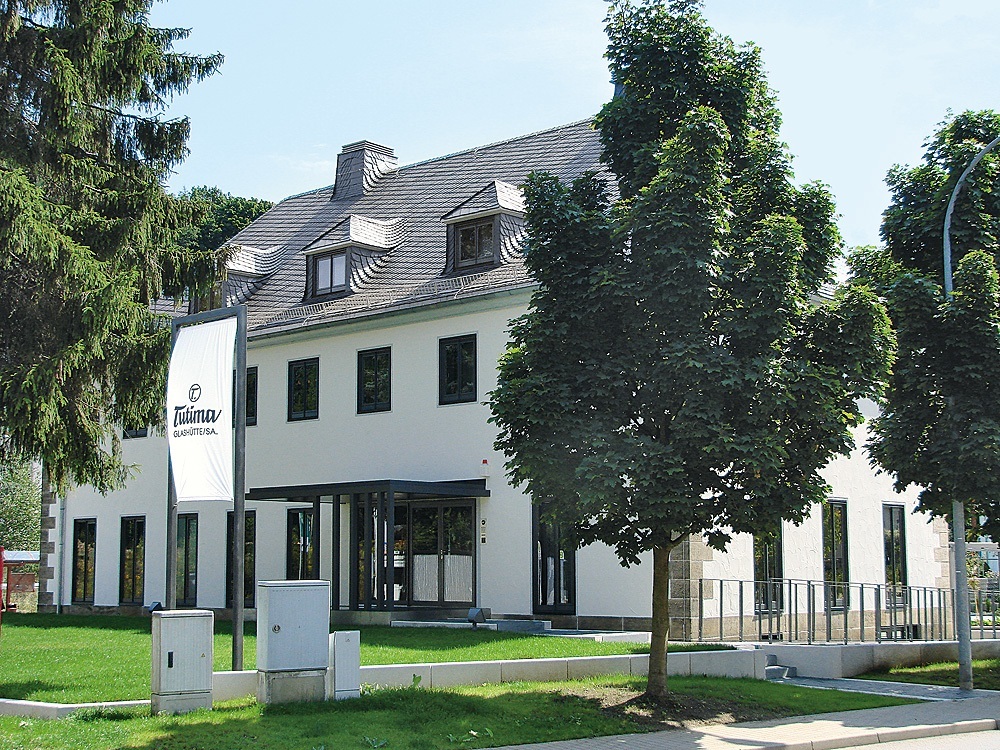
Delecate marked the occasion by unveiling the Tutima Glashütte Hommage Minute Repeater. It is not only the first full minute repeater ever made in Glashütte, it is the first wrist minute repeater in the history of German watchmaking. Its hand-wound movement, Caliber 800, has more than 550 components and was developed and produced in the new manufacture. Delecate said he wanted the first watch Tutima produced upon its return to stand as a tribute to Glashütte’s heritage as “the Mecca of fine German watchmaking,” as he put it. A limited edition of just 25 pieces, 20 in rose gold and five in platinum, will be produced.

Since then, Delecate has shifted all Tutima watch production to Glashütte and opened a second production site. A small technical staff remains in Ganderkesee. In Glashütte, Tutima has redesigned and upgraded its entire line. Today there are four new “Made in Glashütte” collections, all with movements either made entirely or modified in the manufacture. Not surprisingly, many are chronographs.
Saxon One is the flagship collection of sporty but elegant watches, either chronographs ($6,100 and $6,500) or non-chrono automatics ($3,400 and $3,800). The chronograph watches are powered by Tutima Caliber 521, which has an ETA 7750 base modified with a Tutima mechanism for a central chrono minutes hand. The Saxon One automatic is powered by Tutima Caliber 330. (For a review of the Saxon One, click here.)

The M2 is Tutima’s 21st-century version of the NATO Chronograph ($5,900 to $6,700). Since the Lemania 5100 is no longer in production, Tutima uses its 521 caliber in the new line. All M2 watches have solid pearl-blasted titanium cases with 46-mm diameters. Slightly larger (46.5-mm diameter) M2 Pioneer models have 14 luminous capsules on the rotating bezel.

Grand Flieger is the revised and modernized re-edition of the historical 1941 Fliegerchronograph, now in larger cases (43- mm diameter) in chrono ($5,100 and $5,500) and non-chrono versions ($2,500 and $2,900). There are two collections. The Grand Flieger Classic has vintage looks. The Grand Flieger Airport has a contemporary look without the 1940s Arabic numeral hour indicators. The watches are powered by Tutima Calibers 320 (chronographs) and 330 (three-hand automatics).

Patria is a rose-gold dress watch with small seconds subdial at 6 o’clock ($17,900) and, on two models, a dual-time indicator ($19,500). Inside is Tutima Glashütte’s in-house Caliber 617, the hand-wound movement that served as the base for the Hommage Minute Repeater.
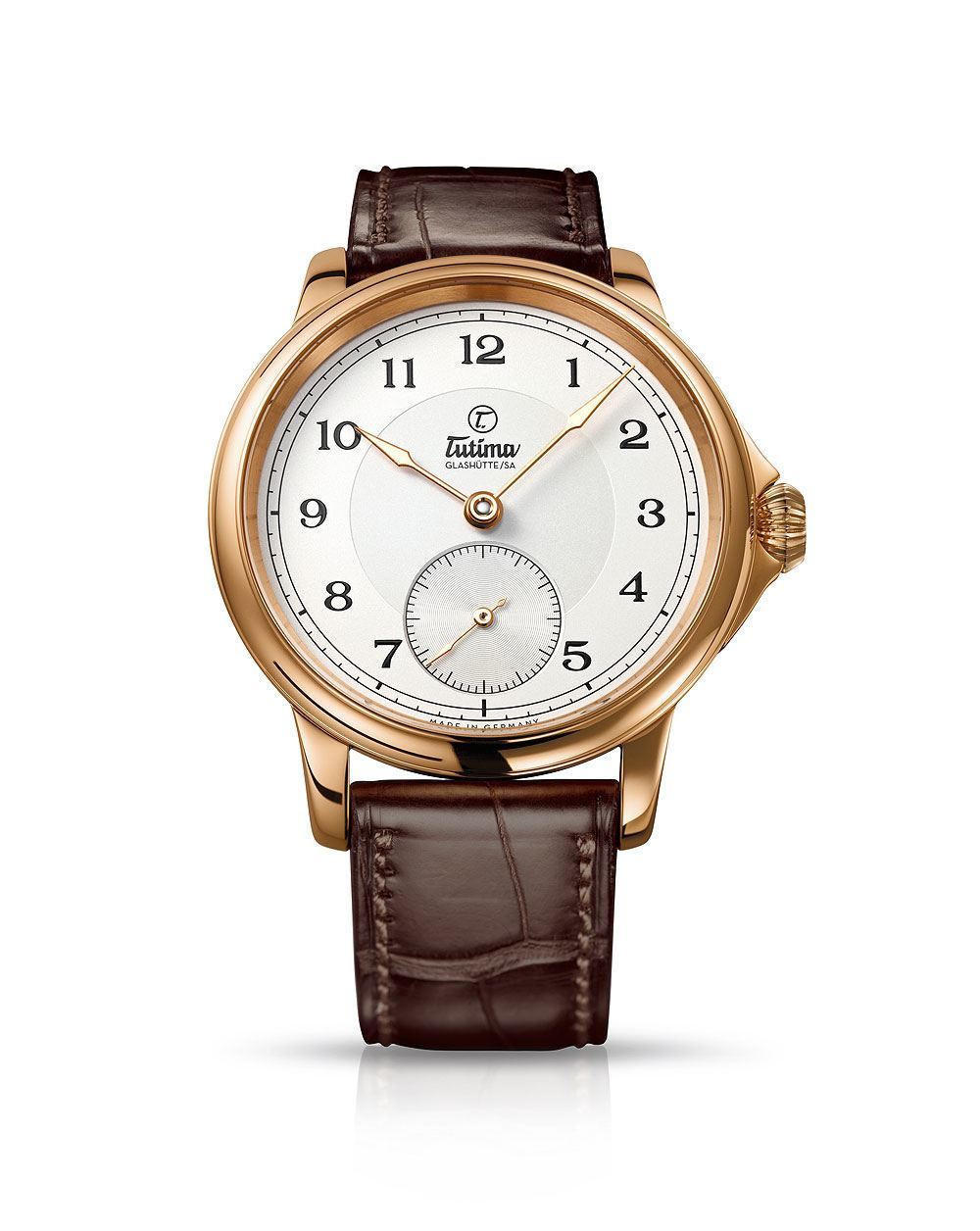
“Here is a new start from zero,” Delecate says of the return to Glashütte. “The minute repeater was the first one, then the new collection. Now we are ready.”
Delicately, I ask Delecate if, after his long, eventful career, having brought the brand home, he ever thinks about retirement. The question doesn’t compute. He stares at me quizzically, then asks, “Are you joking?”
Calzadilla speaks up: “He can’t retire. We’re just getting started.”

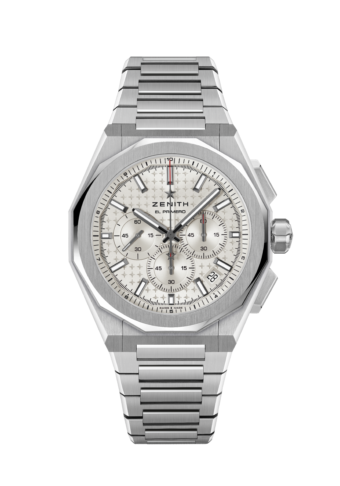
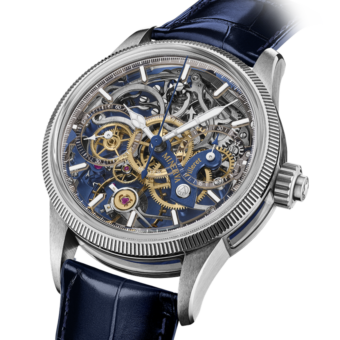
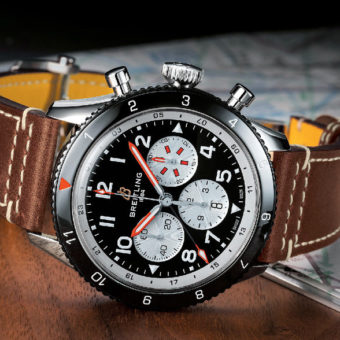
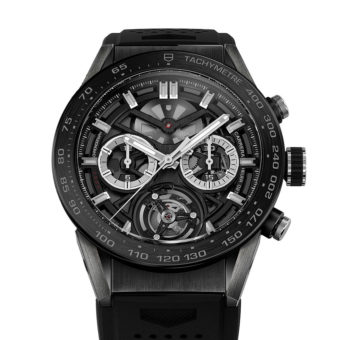
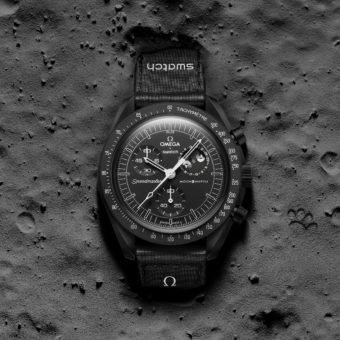
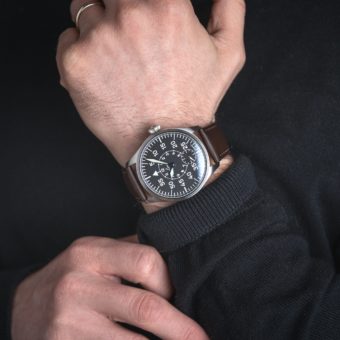
Now that is what you call rugged determination. Bravo!! I am in the market for a Saxon One at the moment. Lovely watch.